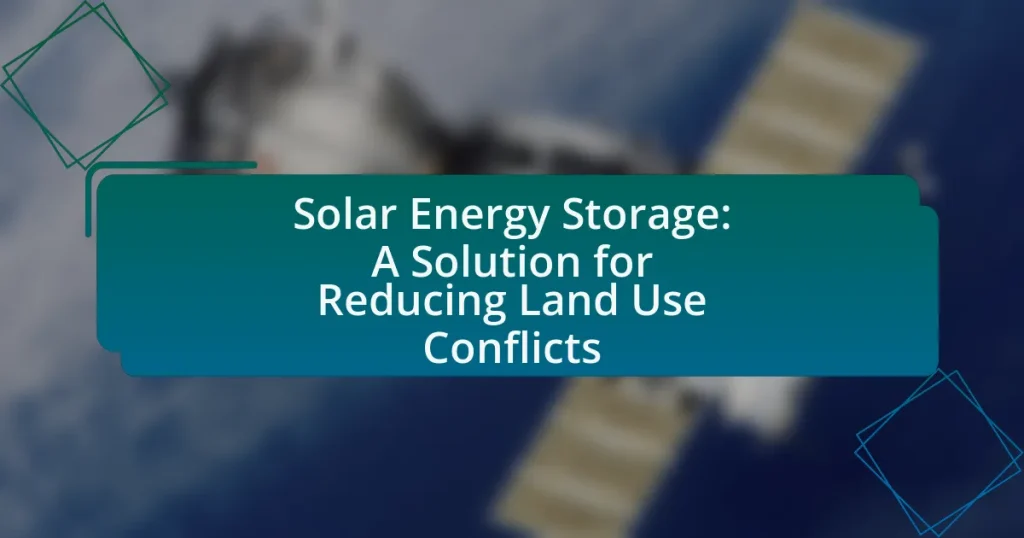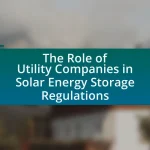Solar energy storage is a technology that captures and stores energy generated from solar panels for later use, playing a crucial role in enhancing the reliability and efficiency of solar power systems. This article explores the functioning of solar energy storage, key technologies such as lithium-ion and flow batteries, and their impact on energy efficiency and environmental benefits. It also addresses land use conflicts associated with solar energy projects, highlighting how solar energy storage can mitigate these issues by optimizing land use and facilitating dual-use systems. Additionally, the article discusses challenges in implementing solar energy storage, including high costs and regulatory hurdles, while proposing solutions and best practices for effective integration into renewable energy systems.
What is Solar Energy Storage and Why is it Important?
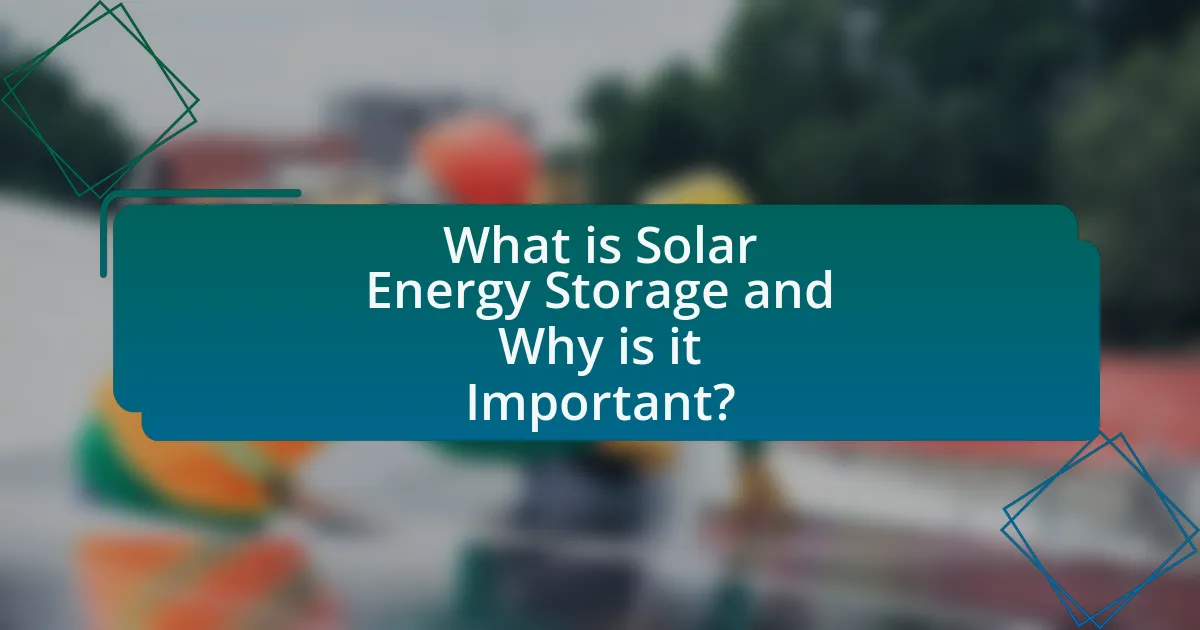

Solar energy storage refers to the technology and systems that capture and store energy generated from solar panels for later use. This is important because it allows for the efficient utilization of solar energy, enabling power availability even when sunlight is not present, such as during nighttime or cloudy days. According to the U.S. Department of Energy, energy storage can enhance grid reliability, reduce energy costs, and support the integration of renewable energy sources, thereby facilitating a transition to a more sustainable energy system.
How does Solar Energy Storage function?
Solar energy storage functions by capturing and storing excess energy generated from solar panels for later use. This process typically involves the use of batteries, such as lithium-ion or flow batteries, which convert the electrical energy produced during sunlight hours into chemical energy for storage. When energy demand exceeds solar generation, the stored energy is converted back into electricity, providing a reliable power supply even when sunlight is not available. According to the U.S. Department of Energy, advancements in battery technology have significantly increased the efficiency and capacity of solar energy storage systems, making them a viable solution for balancing energy supply and demand.
What are the key technologies used in Solar Energy Storage?
The key technologies used in solar energy storage include lithium-ion batteries, flow batteries, and pumped hydro storage. Lithium-ion batteries are widely utilized due to their high energy density and efficiency, making them suitable for residential and commercial applications. Flow batteries, which store energy in liquid electrolytes, offer scalability and longer discharge times, ideal for larger energy systems. Pumped hydro storage, the most established method, uses gravitational potential energy by pumping water to a higher elevation during excess energy production and releasing it to generate electricity when needed. These technologies collectively enhance the reliability and efficiency of solar energy systems, facilitating better integration into the energy grid.
How do these technologies impact energy efficiency?
Solar energy storage technologies significantly enhance energy efficiency by enabling the capture and utilization of solar power during peak production times for use during periods of high demand or low sunlight. This capability reduces reliance on fossil fuels and minimizes energy waste, as stored energy can be deployed when it is most needed, thereby optimizing the overall energy consumption cycle. For instance, according to the National Renewable Energy Laboratory, integrating energy storage with solar systems can increase the effective use of solar energy by up to 50%, demonstrating a clear improvement in energy efficiency.
What role does Solar Energy Storage play in renewable energy systems?
Solar energy storage plays a critical role in renewable energy systems by enabling the capture and retention of solar energy for use during periods of low sunlight or high demand. This capability enhances the reliability and stability of solar power, allowing for a consistent energy supply even when generation is intermittent. For instance, energy storage systems, such as batteries, can store excess energy produced during sunny days and release it during cloudy periods or at night, thus optimizing energy use and reducing reliance on fossil fuels. According to the International Energy Agency, energy storage technologies can significantly increase the share of renewables in the energy mix, facilitating a transition to a more sustainable energy system.
How does it enhance the reliability of solar energy?
Solar energy storage enhances the reliability of solar energy by allowing excess energy generated during peak sunlight hours to be stored and used during periods of low sunlight or high demand. This capability ensures a consistent energy supply, mitigating the intermittent nature of solar power. For instance, battery storage systems can store energy for later use, which has been shown to increase grid stability and reduce reliance on fossil fuels. According to the National Renewable Energy Laboratory, integrating energy storage with solar systems can improve overall energy reliability by up to 30%, demonstrating its effectiveness in maintaining a steady energy supply.
What are the environmental benefits of integrating Solar Energy Storage?
Integrating solar energy storage significantly reduces greenhouse gas emissions by enabling the use of stored solar energy during peak demand times, thus decreasing reliance on fossil fuels. This shift leads to improved air quality, as less combustion of fossil fuels results in lower emissions of pollutants such as sulfur dioxide and nitrogen oxides. Additionally, solar energy storage helps to stabilize the grid, allowing for a more efficient use of renewable energy sources, which further minimizes environmental degradation associated with traditional energy production methods. According to the U.S. Department of Energy, energy storage can reduce the need for peaker plants, which are often powered by natural gas and contribute to carbon emissions.
How can Solar Energy Storage reduce land use conflicts?
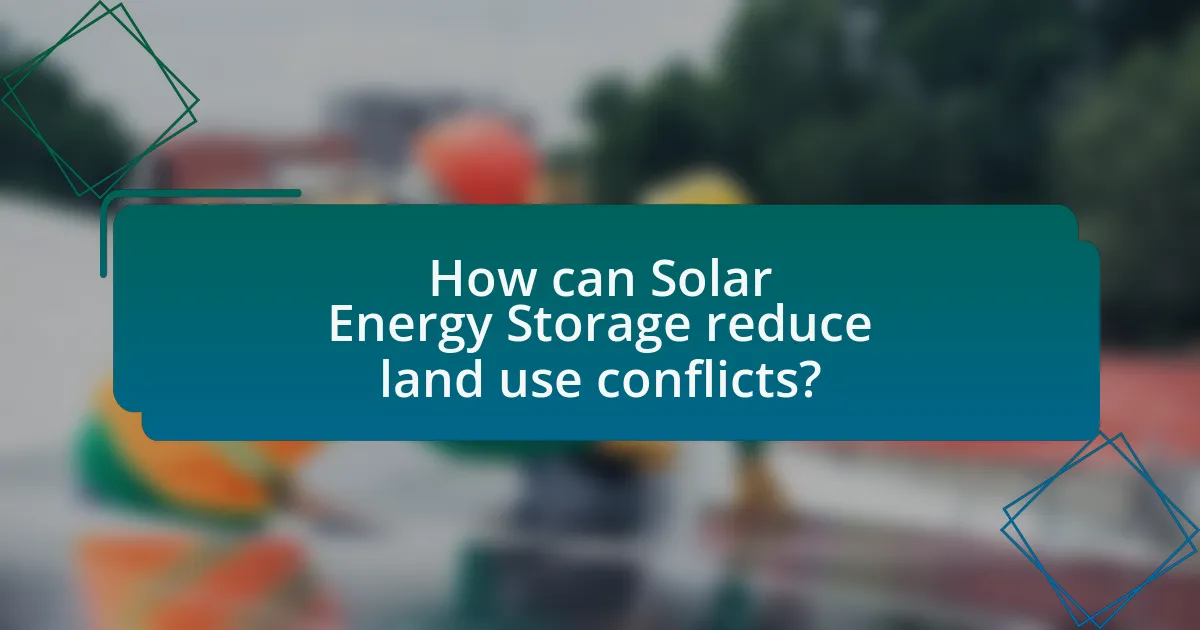

Solar energy storage can reduce land use conflicts by enabling the integration of solar power into existing infrastructure, thereby minimizing the need for new land development. By storing excess solar energy generated during peak sunlight hours, energy can be utilized during periods of high demand without requiring additional land for solar farms. This approach allows for the repurposing of underutilized spaces, such as rooftops or brownfields, which can alleviate competition for agricultural or natural land. Studies indicate that effective energy storage systems can enhance grid reliability and reduce the overall footprint of renewable energy installations, thus mitigating land use disputes.
What are the common land use conflicts associated with solar energy projects?
Common land use conflicts associated with solar energy projects include competition for agricultural land, habitat disruption for wildlife, and conflicts with local communities over land rights. Solar installations often require large areas, which can lead to the conversion of prime agricultural land into solar farms, impacting food production. Additionally, the development of solar projects can disrupt local ecosystems, affecting wildlife habitats and biodiversity. Furthermore, local communities may oppose solar projects due to concerns about land ownership, aesthetic impacts, and potential changes to the character of the area, leading to social conflicts. These conflicts highlight the need for careful planning and stakeholder engagement in solar energy development.
How does Solar Energy Storage mitigate these conflicts?
Solar energy storage mitigates land use conflicts by enabling the efficient use of solar energy even when sunlight is not available, thus reducing the need for extensive land dedicated solely to solar farms. By storing excess energy generated during peak sunlight hours, solar energy storage systems allow for a more flexible energy supply that can be utilized during periods of high demand or low generation, minimizing the footprint of solar installations. This capability helps balance energy supply and demand, reducing the pressure to develop additional land for energy production. For instance, studies have shown that integrating energy storage with solar power can increase the overall efficiency of solar systems, allowing for a smaller land area to meet energy needs while preserving natural habitats and agricultural land.
What examples exist of successful conflict resolution through Solar Energy Storage?
Successful conflict resolution through solar energy storage can be seen in projects like the Hornsdale Power Reserve in South Australia, which integrates solar energy with battery storage to stabilize the grid and reduce reliance on fossil fuels. This project has effectively mitigated disputes over energy supply reliability and environmental concerns by providing a clean, renewable energy source that meets demand without compromising land use. Additionally, the deployment of solar energy storage systems in communities facing land use conflicts, such as agricultural areas, has allowed for dual land use, where solar panels coexist with farming, thus resolving tensions between energy development and agricultural interests. These examples demonstrate how solar energy storage can facilitate cooperation among stakeholders by addressing both energy needs and land use priorities.
Why is land use planning critical in solar energy development?
Land use planning is critical in solar energy development because it ensures the optimal allocation of land resources while minimizing conflicts with existing land uses. Effective land use planning identifies suitable sites for solar installations, taking into account environmental impacts, land availability, and proximity to infrastructure. For instance, studies have shown that poorly planned solar projects can lead to habitat destruction and community opposition, which can delay or halt development. By integrating land use planning into solar energy strategies, developers can enhance project feasibility, reduce regulatory hurdles, and promote sustainable land management practices.
What strategies can be employed to balance solar energy needs with land preservation?
To balance solar energy needs with land preservation, strategies such as dual-use solar systems, rooftop installations, and the development of solar farms on previously disturbed lands can be employed. Dual-use solar systems allow for agricultural activities to coexist with solar panels, maximizing land utility while preserving agricultural output. Rooftop installations utilize existing structures, reducing the need for additional land. Furthermore, placing solar farms on previously disturbed lands, such as brownfields or abandoned industrial sites, minimizes impact on untouched ecosystems. These approaches not only support renewable energy goals but also protect valuable land resources.
How can community engagement influence land use decisions?
Community engagement can significantly influence land use decisions by ensuring that the perspectives and needs of local residents are considered in planning processes. When communities actively participate in discussions about land use, they can advocate for sustainable practices, such as the integration of solar energy storage solutions, which can mitigate land use conflicts. Research indicates that projects with strong community involvement are more likely to gain public support and achieve successful implementation, as seen in various case studies where local input shaped the development of renewable energy projects. This collaborative approach not only enhances transparency but also fosters trust between stakeholders, ultimately leading to more effective and equitable land use outcomes.
What are the challenges and solutions in implementing Solar Energy Storage?
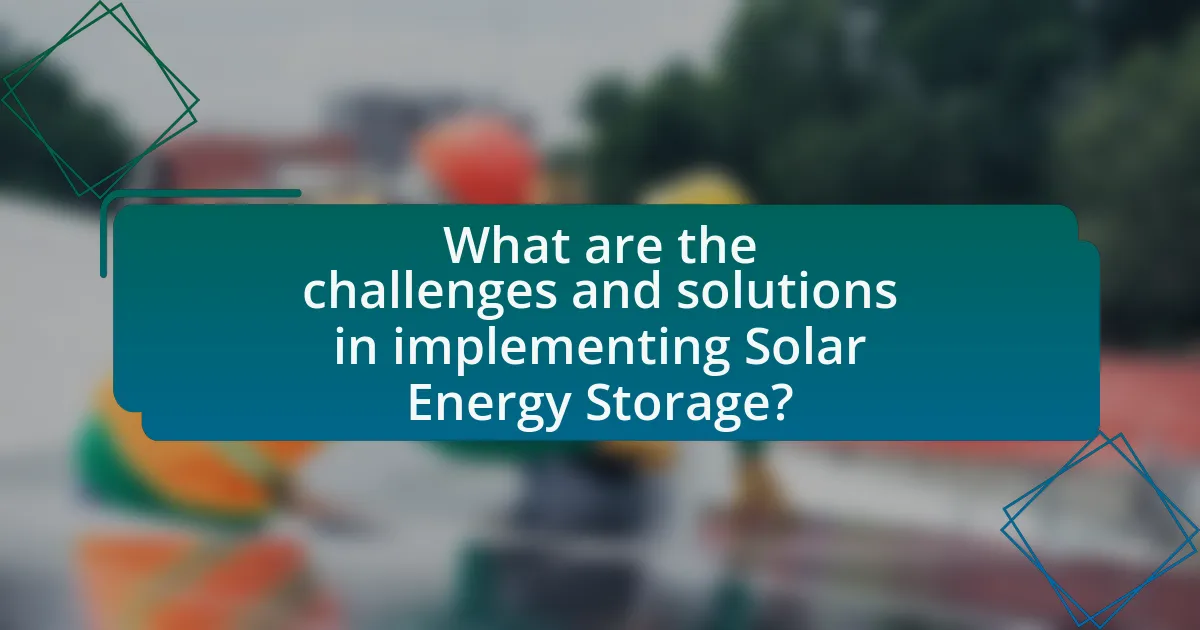

The challenges in implementing solar energy storage include high costs, limited technology options, and regulatory hurdles. High costs are primarily associated with the initial investment in battery systems, which can deter widespread adoption; for instance, lithium-ion batteries, commonly used for solar storage, can cost between $400 to $700 per kilowatt-hour. Limited technology options arise from the current reliance on a few types of batteries, which may not meet all energy storage needs, while regulatory hurdles can complicate the integration of storage systems into existing energy frameworks.
Solutions to these challenges involve advancements in battery technology, government incentives, and improved regulatory frameworks. Research into alternative storage technologies, such as flow batteries and solid-state batteries, aims to reduce costs and enhance efficiency. Government incentives, such as tax credits and grants, can lower the financial burden on consumers and businesses. Additionally, streamlining regulations can facilitate the integration of solar energy storage into the grid, promoting a more sustainable energy future.
What are the main barriers to widespread adoption of Solar Energy Storage?
The main barriers to widespread adoption of solar energy storage include high initial costs, limited technology maturity, regulatory challenges, and insufficient grid infrastructure. High initial costs deter consumers and businesses from investing in solar energy storage systems, as the upfront investment can be significant. Limited technology maturity means that many storage solutions, such as lithium-ion batteries, are still evolving, which can lead to concerns about reliability and longevity. Regulatory challenges arise from inconsistent policies and incentives across different regions, making it difficult for stakeholders to navigate the market. Additionally, insufficient grid infrastructure hampers the integration of solar energy storage, as many existing grids are not equipped to handle the influx of distributed energy resources. These factors collectively hinder the broader adoption of solar energy storage solutions.
How can policy changes facilitate the growth of Solar Energy Storage?
Policy changes can facilitate the growth of solar energy storage by implementing incentives such as tax credits, grants, and subsidies for both manufacturers and consumers. These financial incentives lower the initial investment barrier, encouraging more individuals and businesses to adopt solar energy storage solutions. For instance, the Investment Tax Credit (ITC) in the United States has historically boosted solar installations by allowing a significant percentage of the installation cost to be deducted from federal taxes, leading to a marked increase in solar energy adoption. Additionally, regulatory frameworks that streamline permitting processes and establish clear interconnection standards can enhance market accessibility, further promoting the deployment of solar energy storage systems.
What role do financial incentives play in overcoming these barriers?
Financial incentives play a crucial role in overcoming barriers to solar energy storage by making investments more attractive and feasible for stakeholders. These incentives, such as tax credits, grants, and subsidies, lower the initial costs associated with solar energy systems, thereby encouraging adoption among businesses and consumers. For instance, the federal Investment Tax Credit (ITC) allows for a significant percentage of the installation costs to be deducted from federal taxes, which has historically led to increased solar installations. According to the Solar Energy Industries Association, the ITC has contributed to a 167% increase in solar capacity from 2016 to 2020, demonstrating the effectiveness of financial incentives in driving growth in the solar sector.
What best practices can be adopted for effective Solar Energy Storage implementation?
Effective solar energy storage implementation can be achieved by adopting best practices such as selecting appropriate battery technologies, optimizing system design, and ensuring regular maintenance. Choosing advanced battery technologies, like lithium-ion or flow batteries, enhances efficiency and lifespan, as these options provide higher energy density and longer cycle life compared to traditional lead-acid batteries. Optimizing system design involves integrating energy management systems that balance supply and demand, which can improve overall performance and reduce costs. Regular maintenance, including monitoring battery health and performance, ensures reliability and maximizes the operational lifespan of the storage system. These practices collectively contribute to a more efficient and sustainable solar energy storage solution, addressing land use conflicts effectively.
How can stakeholders collaborate to optimize land use for solar projects?
Stakeholders can collaborate to optimize land use for solar projects by engaging in comprehensive planning and resource-sharing initiatives. This collaboration can involve local governments, energy companies, landowners, and community organizations working together to identify suitable sites that minimize environmental impact while maximizing energy production. For instance, joint assessments of land suitability can lead to the identification of underutilized or degraded lands that are more appropriate for solar installations, thus preserving agricultural and natural areas. Additionally, stakeholders can establish agreements for co-locating solar projects with other land uses, such as agriculture or grazing, which has been shown to enhance land productivity and reduce conflicts. Research indicates that integrated land-use planning can lead to a 30% increase in land efficiency for solar energy projects, demonstrating the effectiveness of collaborative approaches.
What are the key considerations for sustainable Solar Energy Storage systems?
Key considerations for sustainable solar energy storage systems include efficiency, environmental impact, lifecycle management, and scalability. Efficiency is crucial as it determines how much energy can be stored and retrieved, impacting overall system performance. Environmental impact involves assessing the materials used in storage technologies, such as lithium-ion batteries, which can have significant ecological footprints due to mining and disposal processes. Lifecycle management focuses on the entire lifespan of the storage system, including production, usage, and end-of-life recycling or disposal, ensuring minimal waste and resource use. Scalability is essential for adapting storage solutions to various applications, from residential to utility-scale systems, allowing for flexibility in energy management. These factors collectively contribute to the sustainability of solar energy storage systems, ensuring they meet both energy needs and environmental standards.
